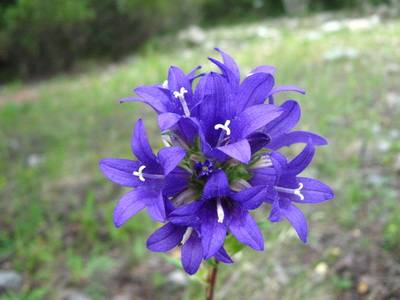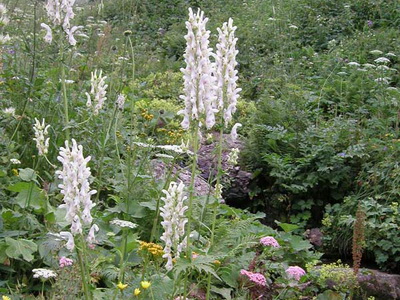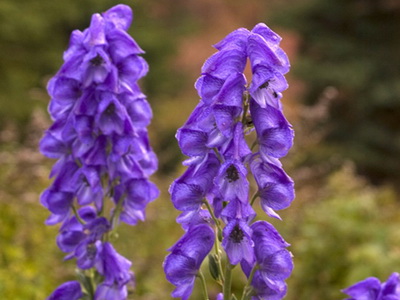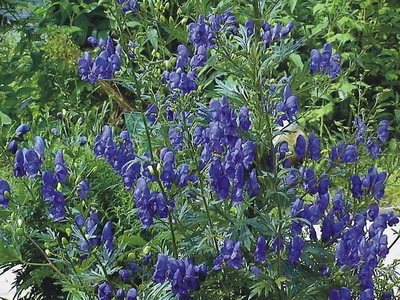If you don’t know what aconite looks like, imagine an upward arrow with a blue or purple tip. It is from the Greek Acontion (“arrows”) that the name of this plant came from – strict and at the same time decorative, powerful and at the same time gentle. Deciding to breed aconite in your garden , be prepared to “repel the attack”, because in just a couple of years it will “capture” a significant part of the territory. The fact is that from the tubers left in the ground, several plants grow annually.
What does an aconite flower look like?
This slender, tall herbaceous plant sometimes reaches a height of up to 1.5 m, belongs to the ranunculus family. Dark green, shiny dissected leaves attract attention with their originality and freshness. But the flowers that sit at the ends of the stems in racemose inflorescences are the most decorative .
The flowers are five-leaved with a spur, dark blue or purple, of a very unusual structure. According to their description, the flowers of the aconite plant resemble a helmet with a lowered visor or an elegant lady’s slipper, hence the popular names of aconite – “skull mantle”, “zozulin laces”.
The roots are strong, branched, have swelling-cones. On the basis of formation, their aconites are divided into 2 groups. The first – nepellus – has small separating swellings; the second – catenata – differs in that the old roots with swellings do not die off and do not separate, but remain connected with new young roots, form a kind of long-term chain of 5-10 tubers (bloatings).
Every year, a new plant grows from last year’s tubers and, thus, the territory is seized. The speed of such movement is 2-3 cm per year.
The species diversity of aconites as an ornamental perennial plant is great. The most common in our gardens is aconite and its garden forms. The height of the stems is from 80 to 100 cm. The shape of the bush is interesting – the stems extend from the root in the form of a pyramid with very strict outlines.
In different climatic zones, other types of aconite are also common, which have a decorative value:
Shaggy aconite. Plant up to 150 cm tall with a long racemose inflorescence up to 30 cm Blooms in July, purple flowers.

Oriental aconite . Tall, up to 150 cm, stem bearing white , yellow and very rarely pale purple flowers. Flower brush up to 50 cm. Blooms in July.

Purple aconite. The plant is relatively low, up to 100 cm. Mostly hybrids with large purple or white flowers are used. Flower brush 40 cm Flowering in July-August.

Aconite bearded. Very original and elegant, despite the gloomy gray-yellow color of the flowers. The brush is compact and short, up to 25 cm. Flowering in July. Plant height – 120 cm.

Curly aconite.Stems decumbent, up to 4 meters long. The panicle of the inflorescence is loose. The flowers are blue. Flowering in August-September. Very undemanding, shade-tolerant plant, used for vertical gardening.

Look at the photo of the plant aconite of various types:




For decorative purposes, aconite is widely used as an original and unpretentious plant.
The unusual color of the flowers makes it essential for creating multicolored landscape paintings where blue and purple tones are in short supply. It is original against a lawn background, in groups with shrubs , trees and flower perennials. So, combinations with phlox , aquilegia are recognized as classic.
The culture is especially in demand as a cut plant.

As you can see in the photo, aconite flowers will decorate any bouquet, besides, they last a long time in the cut and give originality to the composition.
Culture is especially loved by florists. For cutting, the flowers in the brush should bloom by 1/3.
Growing aconite: planting and caring for a flower
Aconite is propagated by seeds , tubers, stem cuttings. For cuttings, young grassy shoots are used, which appear in the spring after the snow melts from overwintered tubers. Later shoots that have developed into tall stems do not take root, because they become woody, stop growing and bloom. After flowering, the stems die.
Tuberous propagation is the most common. Tubers are formed by 2-3 on annual shoots. The tubers separate from the plant in autumn. In the spring, this procedure is not done, because the shoots begin to grow early. Each tuber produces an independent plant.
For successful flower care when planting aconite, the original tuber must have a large bud and strong roots. In September, 2-3 tubers are placed in the hole, but one at a time is possible. Landing distances – 25-30 cm, depth – 20 cm.
Tubers quickly take root, growing into a powerful bush. You can divide the bush after 4-5 years. Flowering during vegetative propagation occurs the next year.
Reproduction by seeds is possible, but flowering will have to wait 3-4 years. In addition, deviations from the variety are possible. Seeds as sowing material must be freshly harvested. Then they have good germination and germinate together in the spring. If you sow the seeds in the spring, they will germinate only next year in the spring, having undergone a natural stratification.
When growing and caring for aconite, remember that at a young age it is very capricious, unlike adult plants.
Emerging shoots need shading, they can not stand the drying of the soil, dry air. Shading, watering , mulching with dry humus should be the main elements in caring for them.
Aconite is considered a very unpretentious, frost-resistant and drought-resistant plant.
Any soil is suitable for him, except for swimming, but, of course, he prefers loose and nutritious. In them, aconite significantly increases the multiplication factor of nodules. Aconite is not picky about fertilizers, but is noticeably grateful even with a small dose of nitrogen top dressing in the spring. The colors of the flowers then turn from gloomy to bright.
Aconite is a penumbra plant. Like any nodule plant, it should not be planted in lowlands where water accumulates, especially in autumn, which threatens the inevitable death of nodules.







